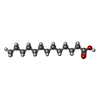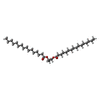+ Open data
Open data
- Basic information
Basic information
| Entry |  | |||||||||
|---|---|---|---|---|---|---|---|---|---|---|
| Title | Bacteroides thetaiotaomicron BAM complex | |||||||||
 Map data Map data | Composite map | |||||||||
 Sample Sample |
| |||||||||
 Keywords Keywords | Outer membrane protein biogenesis / Beta-barrel assembly machinery / BAM / MEMBRANE PROTEIN | |||||||||
| Function / homology |  Function and homology information Function and homology informationmembrane assembly / peptidylprolyl isomerase / cell outer membrane / peptidyl-prolyl cis-trans isomerase activity Similarity search - Function | |||||||||
| Biological species |  Bacteroides thetaiotaomicron VPI-5482 (bacteria) Bacteroides thetaiotaomicron VPI-5482 (bacteria) | |||||||||
| Method | single particle reconstruction / cryo EM / Resolution: 3.46 Å | |||||||||
 Authors Authors | Silale A / van den Berg B | |||||||||
| Funding support |  United Kingdom, 1 items United Kingdom, 1 items
| |||||||||
 Citation Citation |  Journal: Nat Microbiol / Year: 2025 Journal: Nat Microbiol / Year: 2025Title: Structure of a distinct β-barrel assembly machinery complex in the Bacteroidota. Authors: Augustinas Silale / Mariusz Madej / Katarzyna Mikruta / Andrew M Frey / Adam J Hart / Arnaud Baslé / Carsten Scavenius / Jan J Enghild / Matthias Trost / Robert P Hirt / Bert van den Berg /    Abstract: The Gram-negative β-barrel assembly machinery (BAM) complex catalyses the folding and membrane insertion of newly synthesized β-barrel outer membrane proteins. The BAM is structurally conserved, ...The Gram-negative β-barrel assembly machinery (BAM) complex catalyses the folding and membrane insertion of newly synthesized β-barrel outer membrane proteins. The BAM is structurally conserved, but most studies have focused on Gammaproteobacteria. Here, using single-particle cryogenic electron microscopy, quantitative proteomics and functional assays, we show that the BAM complex is distinct within the Bacteroidota. Cryogenic electron microscopy structures of BAM complexes from the human gut symbiont Bacteroides thetaiotaomicron (3.3 Å) and the human oral pathogen Porphyromonas gingivalis (3.2 Å) show similar, seven-component complexes of ~325 kDa. The complexes are mostly extracellular and comprise canonical BamA and BamD; an integral, essential outer membrane protein, BamG, that associates with BamA; and four surface-exposed lipoproteins: BamH-K. Absent from the BAM in Pseudomonadota, BamG-K form a large, extracellular dome that may confer additional functionality to enable the folding and assembly of β-barrel-surface-exposed lipoprotein complexes that are a hallmark of the Bacteroidota. Our findings develop our understanding of fundamental biological processes in an important bacterial phylum. | |||||||||
| History |
|
- Structure visualization
Structure visualization
| Supplemental images |
|---|
- Downloads & links
Downloads & links
-EMDB archive
| Map data |  emd_52209.map.gz emd_52209.map.gz | 299.4 MB |  EMDB map data format EMDB map data format | |
|---|---|---|---|---|
| Header (meta data) |  emd-52209-v30.xml emd-52209-v30.xml emd-52209.xml emd-52209.xml | 25.9 KB 25.9 KB | Display Display |  EMDB header EMDB header |
| Images |  emd_52209.png emd_52209.png | 90.7 KB | ||
| Filedesc metadata |  emd-52209.cif.gz emd-52209.cif.gz | 9 KB | ||
| Archive directory |  http://ftp.pdbj.org/pub/emdb/structures/EMD-52209 http://ftp.pdbj.org/pub/emdb/structures/EMD-52209 ftp://ftp.pdbj.org/pub/emdb/structures/EMD-52209 ftp://ftp.pdbj.org/pub/emdb/structures/EMD-52209 | HTTPS FTP |
-Validation report
| Summary document |  emd_52209_validation.pdf.gz emd_52209_validation.pdf.gz | 523.7 KB | Display |  EMDB validaton report EMDB validaton report |
|---|---|---|---|---|
| Full document |  emd_52209_full_validation.pdf.gz emd_52209_full_validation.pdf.gz | 523.3 KB | Display | |
| Data in XML |  emd_52209_validation.xml.gz emd_52209_validation.xml.gz | 7.7 KB | Display | |
| Data in CIF |  emd_52209_validation.cif.gz emd_52209_validation.cif.gz | 9 KB | Display | |
| Arichive directory |  https://ftp.pdbj.org/pub/emdb/validation_reports/EMD-52209 https://ftp.pdbj.org/pub/emdb/validation_reports/EMD-52209 ftp://ftp.pdbj.org/pub/emdb/validation_reports/EMD-52209 ftp://ftp.pdbj.org/pub/emdb/validation_reports/EMD-52209 | HTTPS FTP |
-Related structure data
| Related structure data |  9hj3MC  9hisC  9hivC  9hjmC C: citing same article ( M: atomic model generated by this map |
|---|---|
| Similar structure data | Similarity search - Function & homology  F&H Search F&H Search |
- Links
Links
| EMDB pages |  EMDB (EBI/PDBe) / EMDB (EBI/PDBe) /  EMDataResource EMDataResource |
|---|---|
| Related items in Molecule of the Month |
- Map
Map
| File |  Download / File: emd_52209.map.gz / Format: CCP4 / Size: 343 MB / Type: IMAGE STORED AS FLOATING POINT NUMBER (4 BYTES) Download / File: emd_52209.map.gz / Format: CCP4 / Size: 343 MB / Type: IMAGE STORED AS FLOATING POINT NUMBER (4 BYTES) | ||||||||||||||||||||||||||||||||||||
|---|---|---|---|---|---|---|---|---|---|---|---|---|---|---|---|---|---|---|---|---|---|---|---|---|---|---|---|---|---|---|---|---|---|---|---|---|---|
| Annotation | Composite map | ||||||||||||||||||||||||||||||||||||
| Projections & slices | Image control
Images are generated by Spider. | ||||||||||||||||||||||||||||||||||||
| Voxel size | X=Y=Z: 0.74 Å | ||||||||||||||||||||||||||||||||||||
| Density |
| ||||||||||||||||||||||||||||||||||||
| Symmetry | Space group: 1 | ||||||||||||||||||||||||||||||||||||
| Details | EMDB XML:
|
-Supplemental data
- Sample components
Sample components
+Entire : Bacteroides thetaiotaomicron BAM complex
+Supramolecule #1: Bacteroides thetaiotaomicron BAM complex
+Macromolecule #1: Outer membrane protein
+Macromolecule #2: Lipoprotein protein, putative
+Macromolecule #3: Outer membrane protein
+Macromolecule #4: DUF6242 domain-containing protein
+Macromolecule #5: Peptidyl-prolyl cis-trans isomerase
+Macromolecule #6: DUF4827 domain-containing protein
+Macromolecule #7: DUF4270 domain-containing protein
+Macromolecule #8: N-TRIDECANOIC ACID
+Macromolecule #9: (2S)-3-hydroxypropane-1,2-diyl dihexadecanoate
-Experimental details
-Structure determination
| Method | cryo EM |
|---|---|
 Processing Processing | single particle reconstruction |
| Aggregation state | particle |
- Sample preparation
Sample preparation
| Concentration | 8 mg/mL | ||||||||||||
|---|---|---|---|---|---|---|---|---|---|---|---|---|---|
| Buffer | pH: 7.5 Component:
| ||||||||||||
| Grid | Model: Quantifoil R1.2/1.3 / Material: COPPER / Mesh: 200 / Support film - Material: CARBON / Support film - topology: HOLEY / Pretreatment - Type: GLOW DISCHARGE / Pretreatment - Atmosphere: AIR | ||||||||||||
| Vitrification | Cryogen name: ETHANE / Chamber humidity: 100 % / Chamber temperature: 277 K / Instrument: FEI VITROBOT MARK IV |
- Electron microscopy
Electron microscopy
| Microscope | TFS KRIOS |
|---|---|
| Specialist optics | Energy filter - Name: TFS Selectris / Energy filter - Slit width: 10 eV |
| Image recording | Film or detector model: FEI FALCON IV (4k x 4k) / Number grids imaged: 1 / Number real images: 13558 / Average electron dose: 35.0 e/Å2 |
| Electron beam | Acceleration voltage: 300 kV / Electron source:  FIELD EMISSION GUN FIELD EMISSION GUN |
| Electron optics | Illumination mode: FLOOD BEAM / Imaging mode: BRIGHT FIELD / Nominal defocus max: 2.0 µm / Nominal defocus min: 0.8 µm / Nominal magnification: 165000 |
| Sample stage | Specimen holder model: FEI TITAN KRIOS AUTOGRID HOLDER / Cooling holder cryogen: NITROGEN |
| Experimental equipment |  Model: Titan Krios / Image courtesy: FEI Company |
+ Image processing
Image processing
-Atomic model buiding 1
| Initial model |
| ||||||
|---|---|---|---|---|---|---|---|
| Details | Experimental models were fit into the combined focused map. | ||||||
| Refinement | Space: REAL / Protocol: RIGID BODY FIT / Overall B value: 64.9 | ||||||
| Output model |  PDB-9hj3: |
 Movie
Movie Controller
Controller










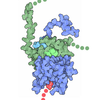
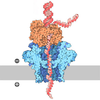
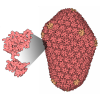
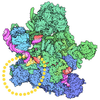

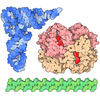


 X (Sec.)
X (Sec.) Y (Row.)
Y (Row.) Z (Col.)
Z (Col.)




















